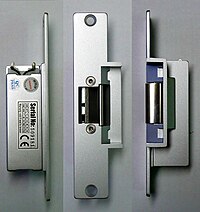
Back Elektriese deurslot Afrikaans Pestell elèctric Catalan Türöffner German Abrepuertas eléctrico Spanish قفل مقابل برقی Persian Deuropener Dutch Elektrisk sluttstykke NB Elektrozaczep Polish Электрозащёлка Russian Elektriskt slutbleck Swedish


An electric strike is an access control device used for door frames. It replaces the fixed strike faceplate often used with a latch (also known as a keeper). Like a fixed strike plate, it normally presents a ramped or beveled surface to the locking latch allowing the door to close and latch just like a fixed strike would. However, an electric strike's ramped surface can, upon command, pivot out of the way when the lock on the door is in the locked position and the door is opened, allowing a user to pull/push the door to open it without operating the mechanical lock or using a mechanical key. After the door is opened past the keeper, the keeper returns to its standard position and re-locks when power is removed or applied, depending upon the strike's configuration.
Electric strikes are generally available in two configurations:
- Fail-secure. Also called fail-locked or non-fail safe. In this configuration, applying electric current to the strike will cause it to unlock. In this configuration, the strike would remain locked in a power failure, but typically the mechanical lock can still be used to open the door from the inside for egress from the secure side. These units can be powered by alternating current, which will cause the unit to buzz, or DC power, which offers silent operation, except for a "click" while the unit is powered.
- Hold-open. In this configuration, an electric current is applied to the strike, causing it to unlock and remain unlocked until it is used. As soon as the strike has been used, it goes back to standard locked position. This is used in many residential, commercial and industrial applications, the Hold-open function ease usage because the powering of the strike and the opening of the strike do not need to be exactly synchronized.
- Fail-safe. Also called fail-open. In this configuration, applying electric current to the strike will cause it to lock. It operates the same as a magnetic lock would. If there is a power failure, the door opens merely by being pushed or pulled.
A new trend is a strike that is quickly reversible from fail safe to fail secure (and back again if needed). Some manufacturers require the opening of the solenoids, but others allow the reversing of the function within seconds (usually take less than 10 seconds) with only the movement of two external screws or a mechanical unlocking accessory which is directly accessible when the door is open. This is exactly the same principle as a child safety door lock which is installed on car doors.
Electric strikes on AC allow someone outside the door to hear when the door is open. The buzzing noise is typically made by applying alternating current (AC) to the strike instead of direct current (DC). When using a DC powered strike, the sound is almost imperceptible.
There are many manufacturers of electric strikes, and there are many things that have to be considered when buying one, i.e., type of jamb, type of locking hardware, whether one requires fail-secure, fail-safe or hold-open function, length of the latch, depth of jamb, voltage requirements and the length of the faceplate. Only in fail-safe situations, it is also a good option to choose a magnetic lock.
Before using a magnetic lock, the Fire Marshal or appropriate authority should be consulted. There are emergency egress issues that must be addressed before using a magnetic lock.